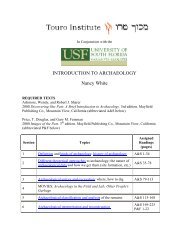In Conjunction with Cultural Anthropology - Touro Institute
In Conjunction with Cultural Anthropology - Touro Institute
In Conjunction with Cultural Anthropology - Touro Institute
You also want an ePaper? Increase the reach of your titles
YUMPU automatically turns print PDFs into web optimized ePapers that Google loves.
a. It is most commonly practiced in tropical forests and savannas.<br />
b. It involves the work of many people in one large garden for each village.<br />
c. It can permit a family to support itself on a single garden plot.<br />
d. It is usually the basis for a completely sedentary village life.<br />
9. Which of the following represents the common view of the origin of pastoralism?<br />
a. It evolved directly from foraging in animal rich environments.<br />
b. It developed as farmers expanded into environmentally less productive zones.<br />
c. It developed in environments where animal husbandry could replace farming.<br />
d. It developed when warfare forced sedentary farmers to become migratory.<br />
10. Which of the following is NOT true of industrialized agriculture?<br />
a. A large percentage of the society is directly involved in food production.<br />
b. It is more productive than traditional agriculture.<br />
c. It is likely to have full-time governments that monopolize political power.<br />
d. Its society is highly urbanized.<br />
Matching Exercise - Chapter 13: Environment, Adaption, and Subsistence<br />
1. scrub forests<br />
2. tropical forests<br />
3. grasslands<br />
4. steppes<br />
5. prairies<br />
6. arid lands<br />
7. boreal forests<br />
8. polar lands<br />
9. tundras<br />
10. taigas<br />
11. carrying capacity<br />
12. subsistence technology<br />
13. foraging<br />
14. communal foraging<br />
15. optimal foraging theory<br />
16. sedentarism<br />
17. horticulture<br />
18. extensive cultivation<br />
19. slash-and-burn cultivation<br />
20. dry-land gardening<br />
21. transhumance<br />
22. intensive cultivation<br />
23. traditional agriculture<br />
24. industrialized agriculture<br />
a. cultivation of crops using simple hand tools such as the hoe and digging stick and<br />
<strong>with</strong>out fertilization of the soil, crop rotation, and often <strong>with</strong>out irrigation<br />
b. living in permanent or semipermanent settlements<br />
c. the use of an industrialized technology and other techniques such as chemical soil<br />
fertilization to obtain high levels of food production per acre<br />
d. regions between coasts and mountains <strong>with</strong> mild, wet winters and hot, dry summers<br />
e. a form of pastoralism in which only a part of the group moves <strong>with</strong> the herd; some<br />
stay in villages and grow crops year round<br />
f. the use of food growing techniques that permit permanent use of the same fields<br />
g. a particular environment's ability to support a species on the available resources<br />
h. principle that foragers use food resources in direct proportion to the caloric effort<br />
required to obtain them
















